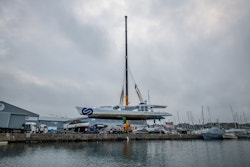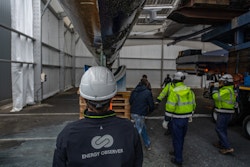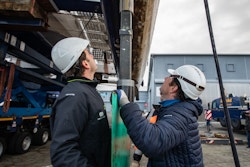Three months of optimization work for Energy Observer
Energy Observer has just come out of the water for a three-month technical pause. Three months of work during which the hydrogen powered catamaran will undergo optimizations and transformations before taking up its world tour again next spring.

The first lap is complete. This Wednesday, December 12th, Energy Observer left its natural habitat to go into the workshop. An impressive hoist out, under tension, that required the use of a 300 ton crane from Nantes. It, with the aid of a self-propelled articulated trailer allowed the 30-meter catamaran, which weighs 30 tonnes, to be transported to its maintenance area.

Energy Observer's Water Outlet
Following 10 months and over 10,000 miles of sailing, the experimental catamaran will undergo some modifications and especially many optimizations.
The work, especially the arrival of a new technological module with the Oceanwings® wings, will last three months.
Optimization phase
Energy Observer is a demonstrator of constant evolution. Like any floating laboratory, it requires time for validation, perfection, and heavier optimization phases. These recent months of navigation have enabled us to accumulate and process an important quantity of data, coming from all the systems, and which will now lead to optimizations. These modifications should allow a gain of productivity up to 15%.
“I will take care of all the flows from the different systems. We’re going to install an innovative circuit to pool the heat sources; so we’ll begin with a phase of dismantling the existing system to start up with a new one.”
An initial optimization will enable Energy Observer to recuperate all the heat produced by the cell to heat the vessel (link to the energy balance paper by Roland). It’s a complete overhaul, including a change of components and pumps to validate the industrial materials that could then be used on other systems. The system will be made more reliable and more simple. Still concerning “plumbing”, for the sake of performance and also appearance, the air intake systems for the fuel cell and the hydrogen system vents will be replaced for better performance.
“Solar” and “hydrogen” engineers
For the engineers, this technical pause will be solar and hydrogen. Hugo Devedeux is taking charge of the solar aspect.
““We’re going to upgrade the system to gain power. That involves changing a hundred panels. They’ll be replaced by custom panels to optimize the available surfaces. A fuel cell provides energy in two forms. 50% in electricity, the other half is thermal energy, which, for the system on-board Energy Observer, represents up to 20 kW. We’re going to work on the thermal aspect. We’re going to implement a storage system that will let us warm the nacelle even when the fuel cell is stopped.”

Energy Observer's Water Outlet
Two very busy captains
For the crew and the two chief mates, Marin Jarry and Jean-Baptiste Sanchez, their “to-do” list is “never-ending”. They are the ones who take charge of the organization of the future works logistics, the coordination of composite alterations related to the implantation of the Oceanwings® wings, while updating the schedule daily to make sure that Energy Observer will be ready for its next trip to Northern Europe in March next year.
“The many changes we’re going to make on the vessel will force us to rethink the boat’s overall operation. A huge number of points are checked to ensure that the vessel can sail in complete safety. The arrival of the Oceanwings® wings will change the vessel’s weight and center of gravity. We must anticipate its behavior at sea, and make sure that these modifications will create a safer and better-performing vessel, able to face all types of weather.”

Energy Observer's Water Outlet
So it will be an Energy Observer with a new look, but most of all, optimized, which will once again take to the seas of Northern Europe by mid-march.